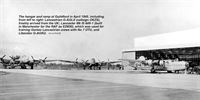Фотографии
-
Регистрационный номер: A66-1, AL547 [2], G-AGKU [2], G-AGLS [2], VD238 [2] The hangar and ramp at Guildford in April 1945, including, from left to right: Lancastrian G-AGLS (callsign OKZS), freshly arrived from the UK; Lancaster Mk III A66-1 (built in Manchester for the RAF as ED930), which was used for training Qantas Lancastrian crews with No 7 OTU, and Liberator G-AGKU.
Самолёты на фотографии: Avro Lancaster / Type 683 - Великобритания - 1941Avro Lancastrian / Type 691 - Великобритания - 1945Consolidated C-87/C-109 Liberator Express - США - 1942
-
Регистрационный номер: AL619 [2], G-AGKT [2] With his distinctive beard and commanding bearing, Capt O.P. Jones (reportedly the first pilot to have covered a million miles by air) poses with Bill Crowther, head of Qantas’s Western Operations Division (fifth from right) and Capt L.R. Ambrose (third from right) among others, beside G-AGKT at Perth.
Самолёты на фотографии: Consolidated C-87/C-109 Liberator Express - США - 1942
-
Регистрационный номер: G-AGTI, VH-EAJ Liberator G-AGTJ, which flew the type’s final Sydney-Singapore service in late August 1946, was acquired by QEA after having been put up for sale via the Commonwealth Disposals Commission, Qantas re-registering the Liberator with Australian civil registration VH-EAJ after its purchase in April 1947. It served for another three years, along with its fellow former Indian Ocean service Liberator G-AGTI (which became VH-EAI), but both had been broken up by the end of 1950.
Самолёты на фотографии: Consolidated C-87/C-109 Liberator Express - США - 1942
-
Регистрационный номер: AL619 [2], G-AGKT [2] Consolidated Liberator 32-3 G-AGKT (former RAF serial AL619) at Guildford, Western Australia, shortly after its delivery in early June 1944. The Liberator represented a significant leap forward from the Catalina, then plying the Indian Ocean route, in terms of capacity, speed and range. Nevertheless, the QEA Liberators were configured to be purely functional, not luxurious.
Самолёты на фотографии: Consolidated C-87/C-109 Liberator Express - США - 1942
-
Регистрационный номер: AL547 [2], G-AGKU [2] Liberator G-AGKU (former RAF serial AL547) at Guildford following its nosewheel collapse, largely a result of a distorted fuselage after a similar incident while serving in North Africa with RAF transport unit No 511 Sqn. Qantas swiftly repaired ’GKU and returned it to service.
Самолёты на фотографии: Consolidated C-87/C-109 Liberator Express - США - 1942
-
An official Qantas certificate from January 1946, documenting that the passenger "has flown the Indian Ocean by the ‘Kangaroo’air service, thus entitling him to membership of the rare and elevated Order of the Longest Hop". The certificate, illustrated with a Liberator, reveals that, in this case, the flight took 17hr 45min.
Самолёты на фотографии: Consolidated C-87/C-109 Liberator Express - США - 1942
-
Регистрационный номер: G-AGLS [2], VD238 [2] Lancastrian G-AGLS (with callsign OKZS prominent on the rear fuselage) arrives at Mascot, Sydney, on April 17, 1945, with Capt Tapp at the controls at the end of its flight from the UK. The aircraft was used at Mascot for Qantas crew training before it flew the first post-war Australia-UK service, departing Sydney on June 2, 1945.
Самолёты на фотографии: Avro Lancastrian / Type 691 - Великобритания - 1945
-
Регистрационный номер: G-AGLV Delivered to BOAC at Croydon by Air Transport Auxiliary pilot Lattice Curtis at the end of April 1945, Lancastrian G-AGLV (callsign OKZV, unmarked) is seen here at Hurn before undertaking the first post-war service from the UK to Australia, with BOAC’s Capt E. Palmer at the controls. The flight took a total flying time of 63hr.
Самолёты на фотографии: Avro Lancastrian / Type 691 - Великобритания - 1945
-
The Avro Lancaster had barely entered service in February 1942 when plans were put in place to create a transport variant for transatlantic services between the UK and Canada. A Mk III was converted to carry passengers and mail, which set a record flight time of 12hr 26min from Dorval to Prestwick in July 1943. Nine Mk Xs were similarly converted by Victory Aircraft in Canada and designated XPPs in Trans-Canada Air Lines service. After the war Avro put the transport variant into production as the Lancastrian, 82 of which were built in four variants.
In the Lancastrian C.I, as used by QEA, a nine-passenger day layout incorporated seating on the port side only, facing outwards towards the starboard wing, as in this view looking towards the front of the aircraft. The seats could be converted into bunks, with further bunks folding down from the panels above, for a six-passenger night configurationСамолёты на фотографии: Avro Lancastrian / Type 691 - Великобритания - 1945
-
Самолёты на фотографии: Avro Lancastrian / Type 691 - Великобритания - 1945
Статьи
- -
- A.Griffith - Ploughshares into Swords
- B.Gooden - Absolute Beginners
- B.Livingstone - The Longest Hop (2)
- C.Gibson - What's French for Fait Accompli..?
- D.Hagedorn - Corsario Jr Legend
- D.Watson - The Highlands, Channel Islands and beyond...
- G.Alegi - From Furniture to Fighter
- K.Hayward - Airbus Industrie
- M.Russell - Bring Out the Big Guns
- P.Davidson - Off the Beaten Track...
- P.Jarrett - Lost & Found
- P.Le Blanc Smith - South by Southeast
- P.Lewis - Where Falcons Dare
- P.Marson - Howard Hughes & the Constellation
- T.Jupp - Everything Must Go









